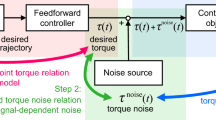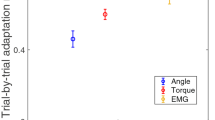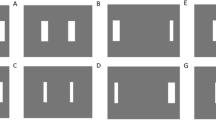Abstract.
It has been proposed that the central nervous system determines reaching movement trajectories so as to minimize the positional variance of the endpoint in the presence of signal-dependent noise. The hypothesis well reproduces the empirical movement trajectories for noise to the control signal whose variance is proportional to the second power of the amplitude of the control signal. However, empirical studies do not necessarily exhibit such a simple signal-noise relationship. The studies exhibit a wide distribution of estimates of the value of the exponent. This discrepancy raises the question of how the minimum endpoint variance trajectory depends on the value of the exponent. To address this question, we calculated minimum endpoint variance trajectories in simulations in which the value of the exponent was varied from 0 to 3. We found that the optimal trajectories differed according to the value of the exponent, and the profiles of optimal trajectories gradually diverged from the empirical ones as the value approached 0, though this change was not remarkable for larger values. Moreover, the optimal trajectories failed to replicate Fitts’ law when the value was not equal to 2. These results suggest that the acceptability of the minimum endpoint variance theory depends on the value of the exponent in our motor system.
Similar content being viewed by others
References
EA Christou LG Carlton (2002) ArticleTitleAge and contraction type influence motor output variability in rapid discrete tasks J Appl Physiol 93 489–498
H Collewjin CJ Erkelens RM Steinman (1988) ArticleTitleBinocular coordination of human horizontal saccadic eye-movements J Physiol 404 157–182
AF Dean (1981) ArticleTitleThe variability of discharge of simple cells in the cat striate cortex Exp Brain Res 44 IssueID4 437–440
T Flash N Hogan (1985) ArticleTitleThe co-ordination of arm movements: an experimentally confirmed mathmatical models J Neurosci 5 IssueID7 1688–1703
AF de C Hamilton DM Wolpert (2002) ArticleTitleControlling the statistics of action: obstacle avoidance J Neurophysiol 87 2434–2440
CM Harris DM Wolpert (1998) ArticleTitleSignal-dependent noise determines motor plannning Nature 394 780–784
M Jeannerod (1988) The neural and behavioural organization of goal-directed movements Oxford University Press New York
KE Jones AF DE C Hamilton DM Wolpert (2002) ArticleTitleSource of signal-dependent noise during isometric force production J Neurophysiol 88 1533–1544
Julier, SJ, Uhlmann JK, Durrant-Whyte HF (1995) A new approach for filtering nonlinear systems. In: Proceedings of the 1995 American control conference, pp 1628–1632
M Kawato (1996) Trajectory formation in arm movements: minimization principles and procedures HN Zelaznik (Eds) Advances in motor learning and control Human Kinetics Champaign, IL
JAS Kelso DL Southard D Goodman (1979) ArticleTitleOn the nature of human interlimb coordination Science 203 1029–1031
S Kitazawa (2002) ArticleTitleOptimization of goal-directed movements in the cerebellum: a random walk hypothesis Neurosci Res 43 IssueID4 289–294
DH Laidlaw M Bilodeau RM Enoka (2000) ArticleTitleSteadness is reduced and motor unit discharge is more variable in old adults Muscle Nerve 23 600–612
D Lee NL Port W Kruse PA Georgopoulos (1998) ArticleTitleVariability and correlated noise in the discharge of neurons in motor and parietal areas of the primate cortex J Neurosci 18 IssueID3 1161–1170
EM Meynard NG Hatsopoulos CL Ojakangas BD Acuna JN Sanes RA Normann JP Donoghue (1999) ArticleTitleNeuronal interactions improve cortial population coding of movement direction J Neurosci 19 IssueID18 8083–8093
CJ McAdams JHR Maunsell (1999) ArticleTitleEffects of attention on the reliability of individual neurons in monkey visual cortex Neuron 23 765–773
Miyamoto H, Nakano E, Wolpert DM, Kawato M (2002) TOPS (Task optimization in the presence of signal-dependent noise) model. The Institute of Electronics, Information and Communication Engineers D-II 86:940–949 (in Japanese)
P Morasso (1981) ArticleTitleSpatial control of arm movements Exp Brain Res 42 223–227
E Todorov (2002) ArticleTitleCosine tuning minimizes motor errors Neural Comput 14 1233–1260
E Todorov MI Jordan (2002) ArticleTitleOptimal feedback control as a theory of motor coordination Nat Neurosci 5 1226–1235
Y Uno M Kawato R Suzuki (1989) ArticleTitleFormation and control of optimal trajectory in human multijoint arm movement Biol Cybern 61 IssueID2 89–101
FCT Helm Particlevan der LA Rozendaal (2000) Musculoskeletal systems with intrinstic and proprioceptive feedback JM Winter PE Crago (Eds) Biomechanics and neural control of posture and movement Springer Berlin Heidelberg New York
JAM Gisbergen Particlevan DA Robinson CCAM Gielen (1981) ArticleTitleA quantitative analysis of generation of saccadic eye movements by burst neurons J Neurophysiol 45 417–442
Author information
Authors and Affiliations
Corresponding author
Additional information
Acknowledgement This work was supported by the Creating the Brain project of CREST, JST, Japan. We thank Dr. S. Kitazawa for helpful comments on this manuscript.
Rights and permissions
About this article
Cite this article
Iguchi, N., Sakaguchi, Y. & Ishida, F. The minimum endpoint variance trajectory depends on the profile of the signal-dependent noise. Biol Cybern 92, 219–228 (2005). https://doi.org/10.1007/s00422-005-0541-7
Received:
Accepted:
Published:
Issue Date:
DOI: https://doi.org/10.1007/s00422-005-0541-7




